Court, Case & McGowan: Employee Performance Management Strategies
VerifiedAdded on 2022/10/14
|13
|3065
|383
Report
AI Summary
This report analyzes the employee performance management challenges faced by Court, Case & McGowan, a Sydney-based law firm. The report begins with an introduction to the human resource's integral role in an organization, emphasizing employee engagement and the impact of pay disparities. It then delves into a strategic analysis of the firm's internal and external environments using tools like the HR matrix, SWOT, and PEST analysis. The core issues identified include low employee motivation due to unclear pay systems, lack of performance management, and inadequate non-monetary rewards. The report further examines the base pay structure, its relationship to the market, and the absence of performance feedback and development opportunities. Key recommendations include establishing a performance appraisal plan, improving compensation structures, implementing non-monetary reward systems, and fostering employee development to address these issues and improve overall organizational success. The report concludes with proposed implementation plans, emphasizing the formation of a performance appraisal plan to overcome the identified workplace challenges.
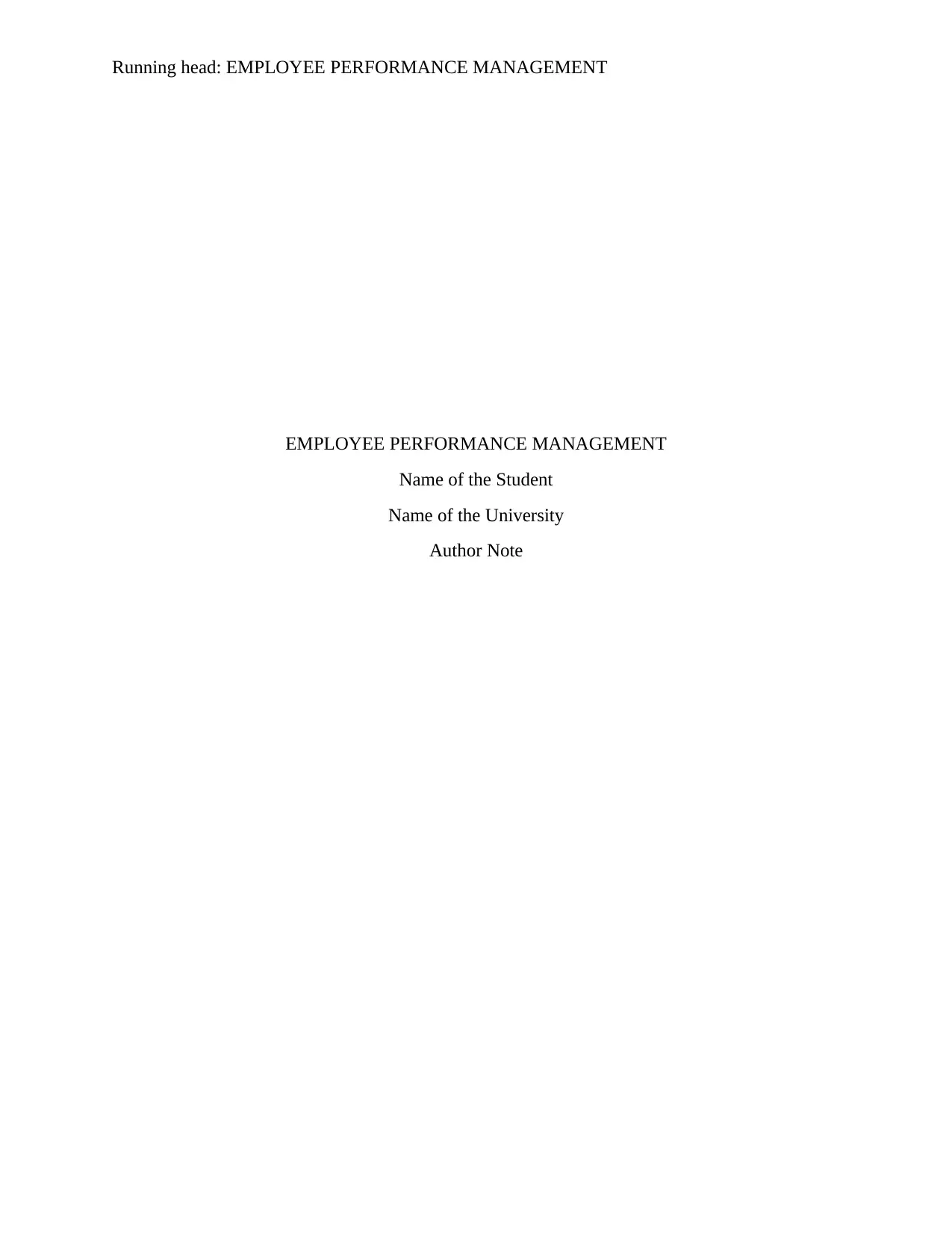
Running head: EMPLOYEE PERFORMANCE MANAGEMENT
EMPLOYEE PERFORMANCE MANAGEMENT
Name of the Student
Name of the University
Author Note
EMPLOYEE PERFORMANCE MANAGEMENT
Name of the Student
Name of the University
Author Note
Paraphrase This Document
Need a fresh take? Get an instant paraphrase of this document with our AI Paraphraser
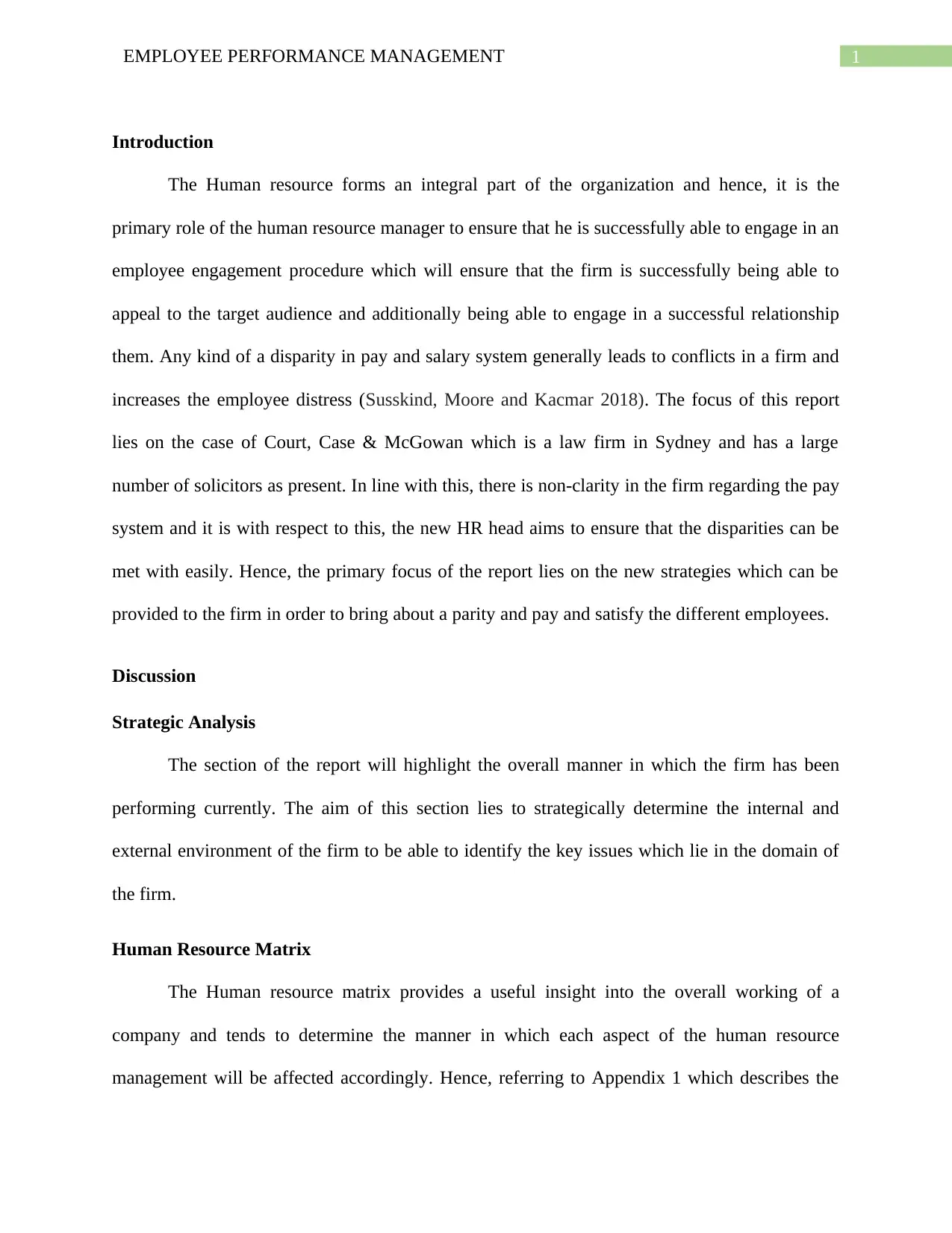
1EMPLOYEE PERFORMANCE MANAGEMENT
Introduction
The Human resource forms an integral part of the organization and hence, it is the
primary role of the human resource manager to ensure that he is successfully able to engage in an
employee engagement procedure which will ensure that the firm is successfully being able to
appeal to the target audience and additionally being able to engage in a successful relationship
them. Any kind of a disparity in pay and salary system generally leads to conflicts in a firm and
increases the employee distress (Susskind, Moore and Kacmar 2018). The focus of this report
lies on the case of Court, Case & McGowan which is a law firm in Sydney and has a large
number of solicitors as present. In line with this, there is non-clarity in the firm regarding the pay
system and it is with respect to this, the new HR head aims to ensure that the disparities can be
met with easily. Hence, the primary focus of the report lies on the new strategies which can be
provided to the firm in order to bring about a parity and pay and satisfy the different employees.
Discussion
Strategic Analysis
The section of the report will highlight the overall manner in which the firm has been
performing currently. The aim of this section lies to strategically determine the internal and
external environment of the firm to be able to identify the key issues which lie in the domain of
the firm.
Human Resource Matrix
The Human resource matrix provides a useful insight into the overall working of a
company and tends to determine the manner in which each aspect of the human resource
management will be affected accordingly. Hence, referring to Appendix 1 which describes the
Introduction
The Human resource forms an integral part of the organization and hence, it is the
primary role of the human resource manager to ensure that he is successfully able to engage in an
employee engagement procedure which will ensure that the firm is successfully being able to
appeal to the target audience and additionally being able to engage in a successful relationship
them. Any kind of a disparity in pay and salary system generally leads to conflicts in a firm and
increases the employee distress (Susskind, Moore and Kacmar 2018). The focus of this report
lies on the case of Court, Case & McGowan which is a law firm in Sydney and has a large
number of solicitors as present. In line with this, there is non-clarity in the firm regarding the pay
system and it is with respect to this, the new HR head aims to ensure that the disparities can be
met with easily. Hence, the primary focus of the report lies on the new strategies which can be
provided to the firm in order to bring about a parity and pay and satisfy the different employees.
Discussion
Strategic Analysis
The section of the report will highlight the overall manner in which the firm has been
performing currently. The aim of this section lies to strategically determine the internal and
external environment of the firm to be able to identify the key issues which lie in the domain of
the firm.
Human Resource Matrix
The Human resource matrix provides a useful insight into the overall working of a
company and tends to determine the manner in which each aspect of the human resource
management will be affected accordingly. Hence, referring to Appendix 1 which describes the
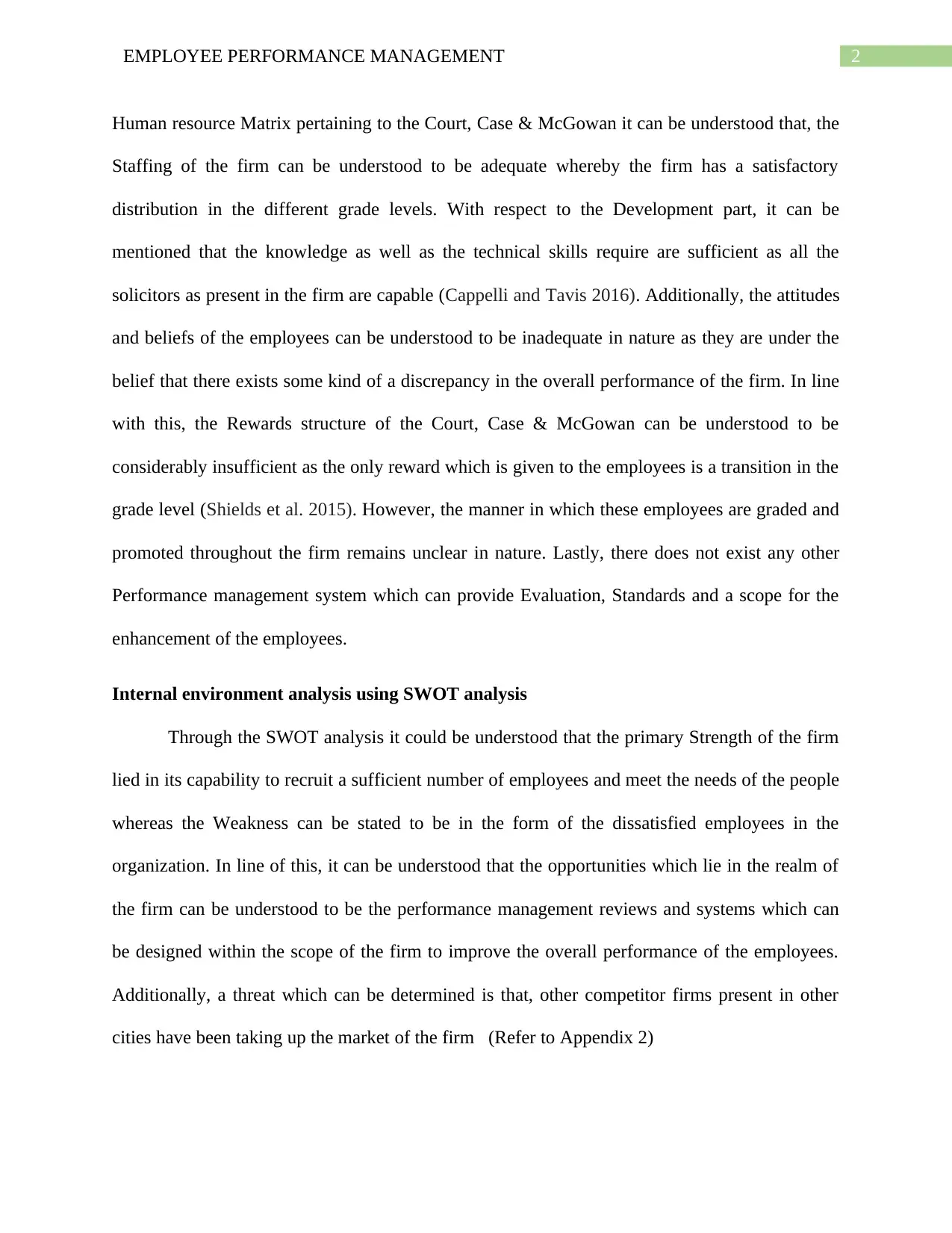
2EMPLOYEE PERFORMANCE MANAGEMENT
Human resource Matrix pertaining to the Court, Case & McGowan it can be understood that, the
Staffing of the firm can be understood to be adequate whereby the firm has a satisfactory
distribution in the different grade levels. With respect to the Development part, it can be
mentioned that the knowledge as well as the technical skills require are sufficient as all the
solicitors as present in the firm are capable (Cappelli and Tavis 2016). Additionally, the attitudes
and beliefs of the employees can be understood to be inadequate in nature as they are under the
belief that there exists some kind of a discrepancy in the overall performance of the firm. In line
with this, the Rewards structure of the Court, Case & McGowan can be understood to be
considerably insufficient as the only reward which is given to the employees is a transition in the
grade level (Shields et al. 2015). However, the manner in which these employees are graded and
promoted throughout the firm remains unclear in nature. Lastly, there does not exist any other
Performance management system which can provide Evaluation, Standards and a scope for the
enhancement of the employees.
Internal environment analysis using SWOT analysis
Through the SWOT analysis it could be understood that the primary Strength of the firm
lied in its capability to recruit a sufficient number of employees and meet the needs of the people
whereas the Weakness can be stated to be in the form of the dissatisfied employees in the
organization. In line of this, it can be understood that the opportunities which lie in the realm of
the firm can be understood to be the performance management reviews and systems which can
be designed within the scope of the firm to improve the overall performance of the employees.
Additionally, a threat which can be determined is that, other competitor firms present in other
cities have been taking up the market of the firm (Refer to Appendix 2)
Human resource Matrix pertaining to the Court, Case & McGowan it can be understood that, the
Staffing of the firm can be understood to be adequate whereby the firm has a satisfactory
distribution in the different grade levels. With respect to the Development part, it can be
mentioned that the knowledge as well as the technical skills require are sufficient as all the
solicitors as present in the firm are capable (Cappelli and Tavis 2016). Additionally, the attitudes
and beliefs of the employees can be understood to be inadequate in nature as they are under the
belief that there exists some kind of a discrepancy in the overall performance of the firm. In line
with this, the Rewards structure of the Court, Case & McGowan can be understood to be
considerably insufficient as the only reward which is given to the employees is a transition in the
grade level (Shields et al. 2015). However, the manner in which these employees are graded and
promoted throughout the firm remains unclear in nature. Lastly, there does not exist any other
Performance management system which can provide Evaluation, Standards and a scope for the
enhancement of the employees.
Internal environment analysis using SWOT analysis
Through the SWOT analysis it could be understood that the primary Strength of the firm
lied in its capability to recruit a sufficient number of employees and meet the needs of the people
whereas the Weakness can be stated to be in the form of the dissatisfied employees in the
organization. In line of this, it can be understood that the opportunities which lie in the realm of
the firm can be understood to be the performance management reviews and systems which can
be designed within the scope of the firm to improve the overall performance of the employees.
Additionally, a threat which can be determined is that, other competitor firms present in other
cities have been taking up the market of the firm (Refer to Appendix 2)
⊘ This is a preview!⊘
Do you want full access?
Subscribe today to unlock all pages.

Trusted by 1+ million students worldwide
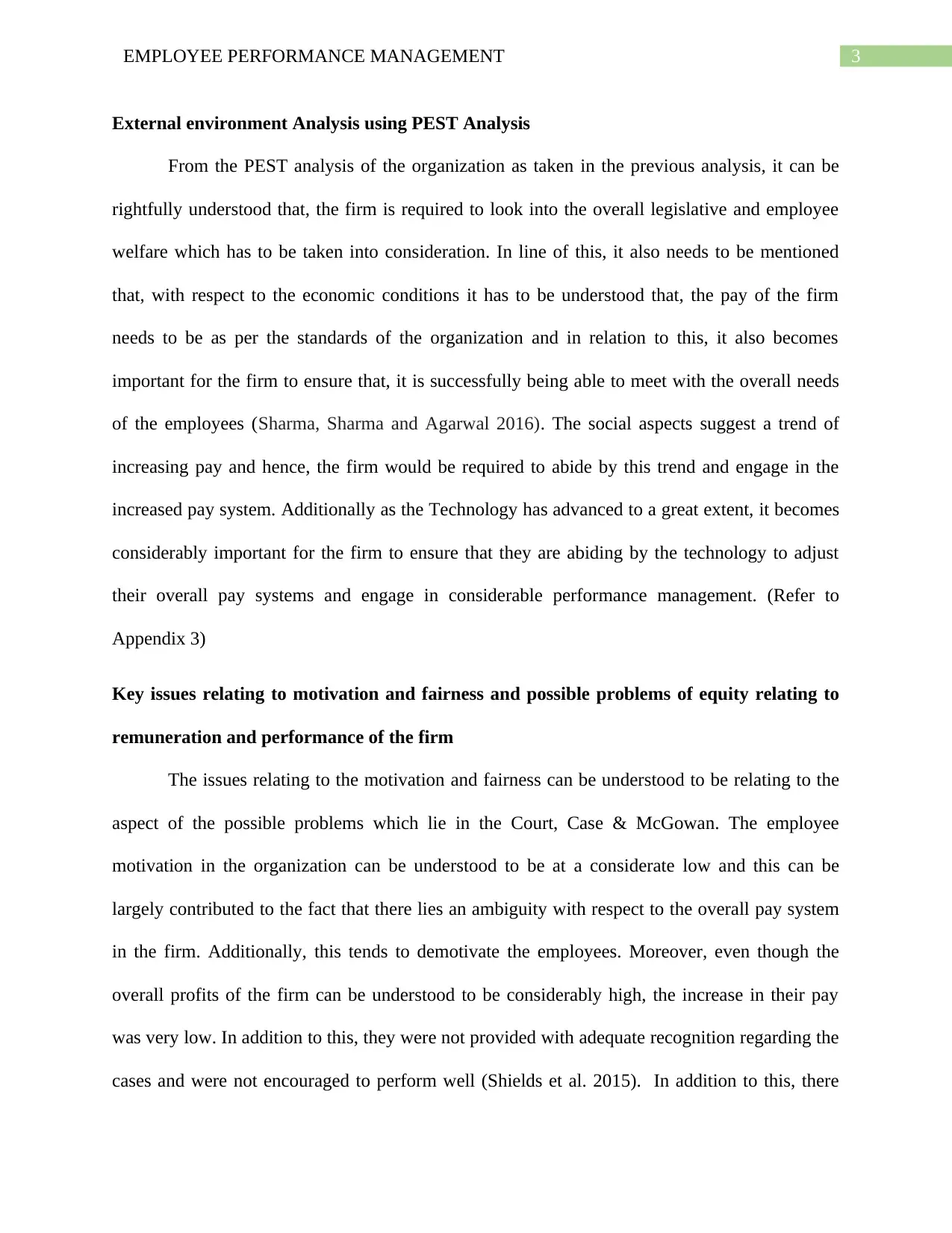
3EMPLOYEE PERFORMANCE MANAGEMENT
External environment Analysis using PEST Analysis
From the PEST analysis of the organization as taken in the previous analysis, it can be
rightfully understood that, the firm is required to look into the overall legislative and employee
welfare which has to be taken into consideration. In line of this, it also needs to be mentioned
that, with respect to the economic conditions it has to be understood that, the pay of the firm
needs to be as per the standards of the organization and in relation to this, it also becomes
important for the firm to ensure that, it is successfully being able to meet with the overall needs
of the employees (Sharma, Sharma and Agarwal 2016). The social aspects suggest a trend of
increasing pay and hence, the firm would be required to abide by this trend and engage in the
increased pay system. Additionally as the Technology has advanced to a great extent, it becomes
considerably important for the firm to ensure that they are abiding by the technology to adjust
their overall pay systems and engage in considerable performance management. (Refer to
Appendix 3)
Key issues relating to motivation and fairness and possible problems of equity relating to
remuneration and performance of the firm
The issues relating to the motivation and fairness can be understood to be relating to the
aspect of the possible problems which lie in the Court, Case & McGowan. The employee
motivation in the organization can be understood to be at a considerate low and this can be
largely contributed to the fact that there lies an ambiguity with respect to the overall pay system
in the firm. Additionally, this tends to demotivate the employees. Moreover, even though the
overall profits of the firm can be understood to be considerably high, the increase in their pay
was very low. In addition to this, they were not provided with adequate recognition regarding the
cases and were not encouraged to perform well (Shields et al. 2015). In addition to this, there
External environment Analysis using PEST Analysis
From the PEST analysis of the organization as taken in the previous analysis, it can be
rightfully understood that, the firm is required to look into the overall legislative and employee
welfare which has to be taken into consideration. In line of this, it also needs to be mentioned
that, with respect to the economic conditions it has to be understood that, the pay of the firm
needs to be as per the standards of the organization and in relation to this, it also becomes
important for the firm to ensure that, it is successfully being able to meet with the overall needs
of the employees (Sharma, Sharma and Agarwal 2016). The social aspects suggest a trend of
increasing pay and hence, the firm would be required to abide by this trend and engage in the
increased pay system. Additionally as the Technology has advanced to a great extent, it becomes
considerably important for the firm to ensure that they are abiding by the technology to adjust
their overall pay systems and engage in considerable performance management. (Refer to
Appendix 3)
Key issues relating to motivation and fairness and possible problems of equity relating to
remuneration and performance of the firm
The issues relating to the motivation and fairness can be understood to be relating to the
aspect of the possible problems which lie in the Court, Case & McGowan. The employee
motivation in the organization can be understood to be at a considerate low and this can be
largely contributed to the fact that there lies an ambiguity with respect to the overall pay system
in the firm. Additionally, this tends to demotivate the employees. Moreover, even though the
overall profits of the firm can be understood to be considerably high, the increase in their pay
was very low. In addition to this, they were not provided with adequate recognition regarding the
cases and were not encouraged to perform well (Shields et al. 2015). In addition to this, there
Paraphrase This Document
Need a fresh take? Get an instant paraphrase of this document with our AI Paraphraser
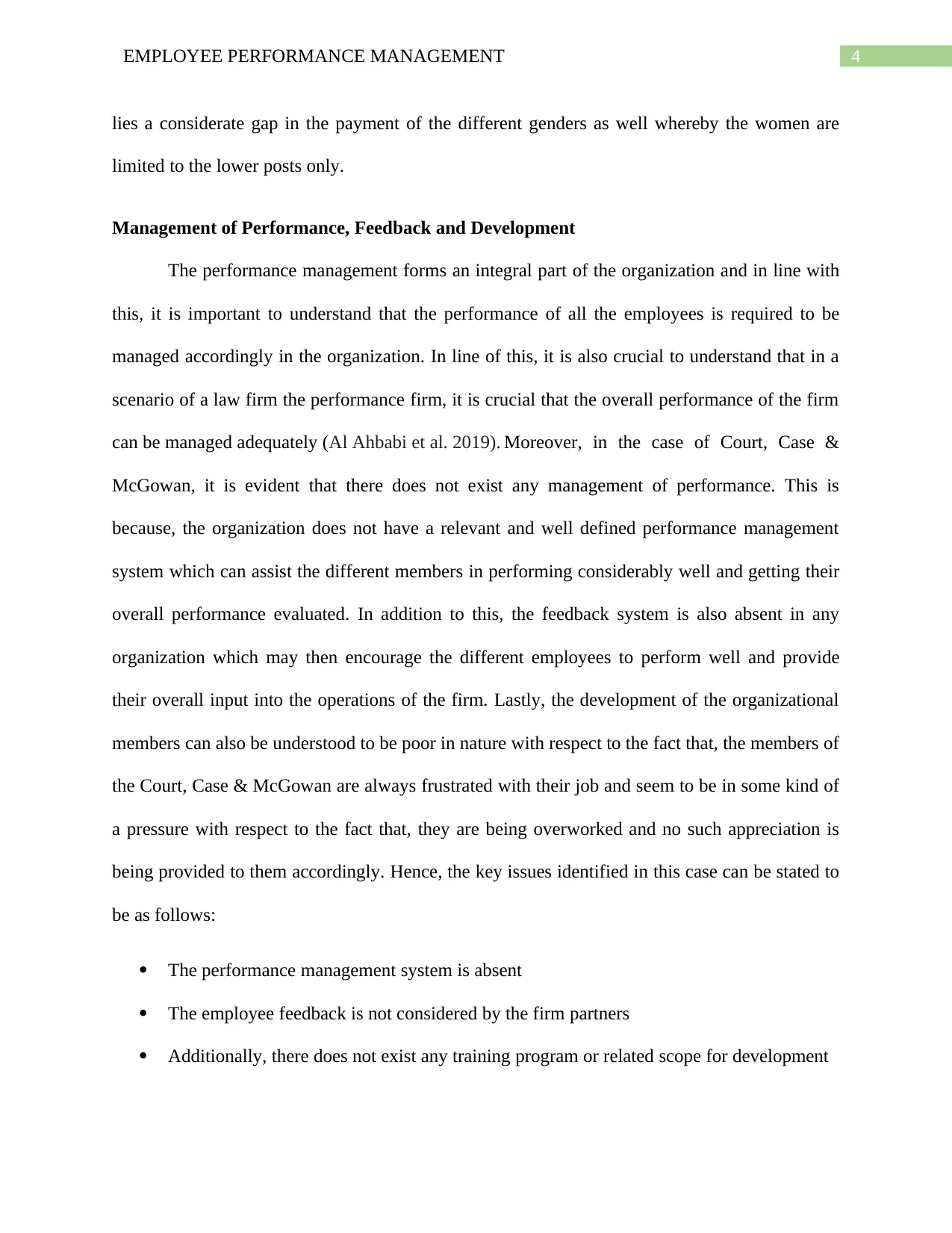
4EMPLOYEE PERFORMANCE MANAGEMENT
lies a considerate gap in the payment of the different genders as well whereby the women are
limited to the lower posts only.
Management of Performance, Feedback and Development
The performance management forms an integral part of the organization and in line with
this, it is important to understand that the performance of all the employees is required to be
managed accordingly in the organization. In line of this, it is also crucial to understand that in a
scenario of a law firm the performance firm, it is crucial that the overall performance of the firm
can be managed adequately (Al Ahbabi et al. 2019). Moreover, in the case of Court, Case &
McGowan, it is evident that there does not exist any management of performance. This is
because, the organization does not have a relevant and well defined performance management
system which can assist the different members in performing considerably well and getting their
overall performance evaluated. In addition to this, the feedback system is also absent in any
organization which may then encourage the different employees to perform well and provide
their overall input into the operations of the firm. Lastly, the development of the organizational
members can also be understood to be poor in nature with respect to the fact that, the members of
the Court, Case & McGowan are always frustrated with their job and seem to be in some kind of
a pressure with respect to the fact that, they are being overworked and no such appreciation is
being provided to them accordingly. Hence, the key issues identified in this case can be stated to
be as follows:
The performance management system is absent
The employee feedback is not considered by the firm partners
Additionally, there does not exist any training program or related scope for development
lies a considerate gap in the payment of the different genders as well whereby the women are
limited to the lower posts only.
Management of Performance, Feedback and Development
The performance management forms an integral part of the organization and in line with
this, it is important to understand that the performance of all the employees is required to be
managed accordingly in the organization. In line of this, it is also crucial to understand that in a
scenario of a law firm the performance firm, it is crucial that the overall performance of the firm
can be managed adequately (Al Ahbabi et al. 2019). Moreover, in the case of Court, Case &
McGowan, it is evident that there does not exist any management of performance. This is
because, the organization does not have a relevant and well defined performance management
system which can assist the different members in performing considerably well and getting their
overall performance evaluated. In addition to this, the feedback system is also absent in any
organization which may then encourage the different employees to perform well and provide
their overall input into the operations of the firm. Lastly, the development of the organizational
members can also be understood to be poor in nature with respect to the fact that, the members of
the Court, Case & McGowan are always frustrated with their job and seem to be in some kind of
a pressure with respect to the fact that, they are being overworked and no such appreciation is
being provided to them accordingly. Hence, the key issues identified in this case can be stated to
be as follows:
The performance management system is absent
The employee feedback is not considered by the firm partners
Additionally, there does not exist any training program or related scope for development
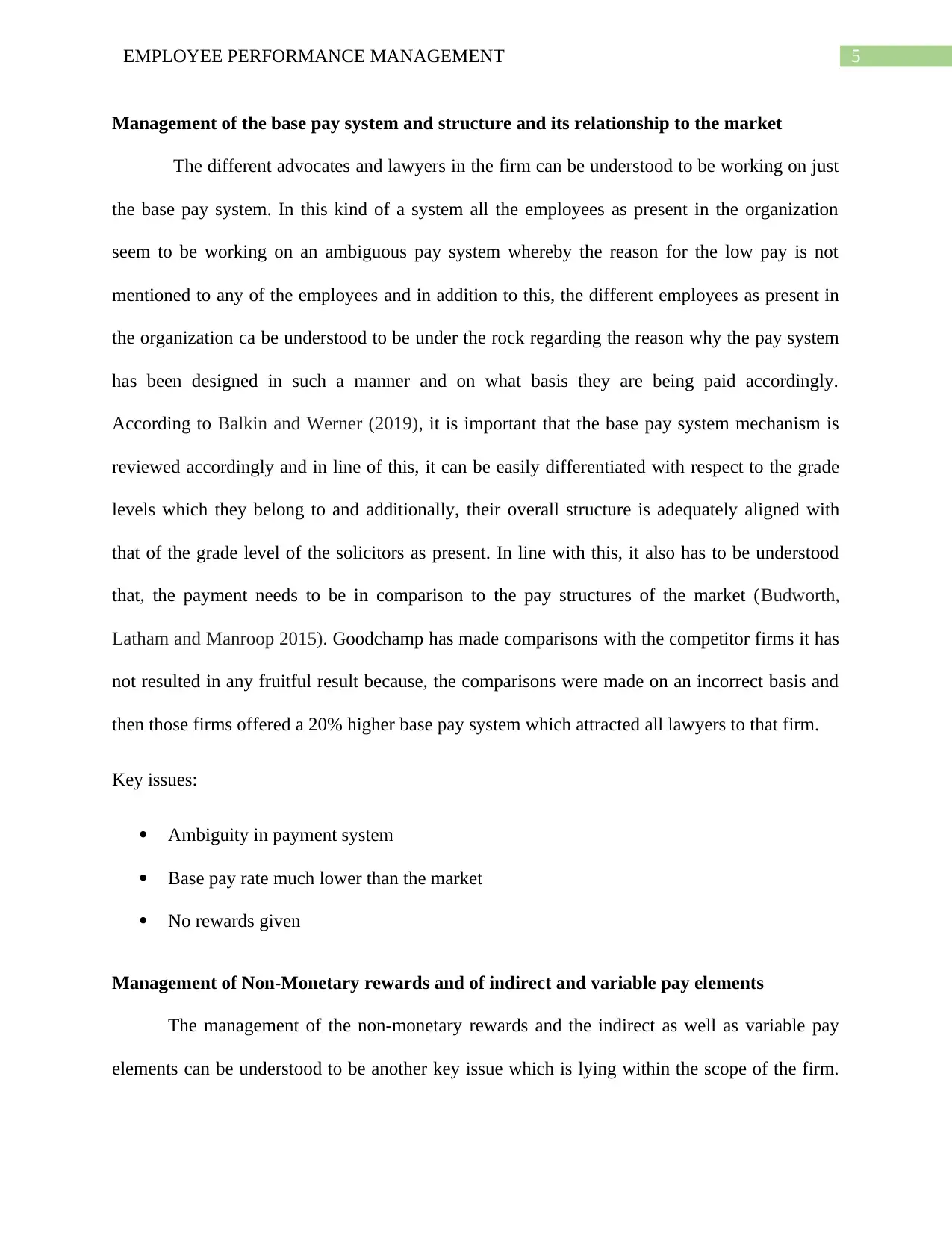
5EMPLOYEE PERFORMANCE MANAGEMENT
Management of the base pay system and structure and its relationship to the market
The different advocates and lawyers in the firm can be understood to be working on just
the base pay system. In this kind of a system all the employees as present in the organization
seem to be working on an ambiguous pay system whereby the reason for the low pay is not
mentioned to any of the employees and in addition to this, the different employees as present in
the organization ca be understood to be under the rock regarding the reason why the pay system
has been designed in such a manner and on what basis they are being paid accordingly.
According to Balkin and Werner (2019), it is important that the base pay system mechanism is
reviewed accordingly and in line of this, it can be easily differentiated with respect to the grade
levels which they belong to and additionally, their overall structure is adequately aligned with
that of the grade level of the solicitors as present. In line with this, it also has to be understood
that, the payment needs to be in comparison to the pay structures of the market (Budworth,
Latham and Manroop 2015). Goodchamp has made comparisons with the competitor firms it has
not resulted in any fruitful result because, the comparisons were made on an incorrect basis and
then those firms offered a 20% higher base pay system which attracted all lawyers to that firm.
Key issues:
Ambiguity in payment system
Base pay rate much lower than the market
No rewards given
Management of Non-Monetary rewards and of indirect and variable pay elements
The management of the non-monetary rewards and the indirect as well as variable pay
elements can be understood to be another key issue which is lying within the scope of the firm.
Management of the base pay system and structure and its relationship to the market
The different advocates and lawyers in the firm can be understood to be working on just
the base pay system. In this kind of a system all the employees as present in the organization
seem to be working on an ambiguous pay system whereby the reason for the low pay is not
mentioned to any of the employees and in addition to this, the different employees as present in
the organization ca be understood to be under the rock regarding the reason why the pay system
has been designed in such a manner and on what basis they are being paid accordingly.
According to Balkin and Werner (2019), it is important that the base pay system mechanism is
reviewed accordingly and in line of this, it can be easily differentiated with respect to the grade
levels which they belong to and additionally, their overall structure is adequately aligned with
that of the grade level of the solicitors as present. In line with this, it also has to be understood
that, the payment needs to be in comparison to the pay structures of the market (Budworth,
Latham and Manroop 2015). Goodchamp has made comparisons with the competitor firms it has
not resulted in any fruitful result because, the comparisons were made on an incorrect basis and
then those firms offered a 20% higher base pay system which attracted all lawyers to that firm.
Key issues:
Ambiguity in payment system
Base pay rate much lower than the market
No rewards given
Management of Non-Monetary rewards and of indirect and variable pay elements
The management of the non-monetary rewards and the indirect as well as variable pay
elements can be understood to be another key issue which is lying within the scope of the firm.
⊘ This is a preview!⊘
Do you want full access?
Subscribe today to unlock all pages.

Trusted by 1+ million students worldwide
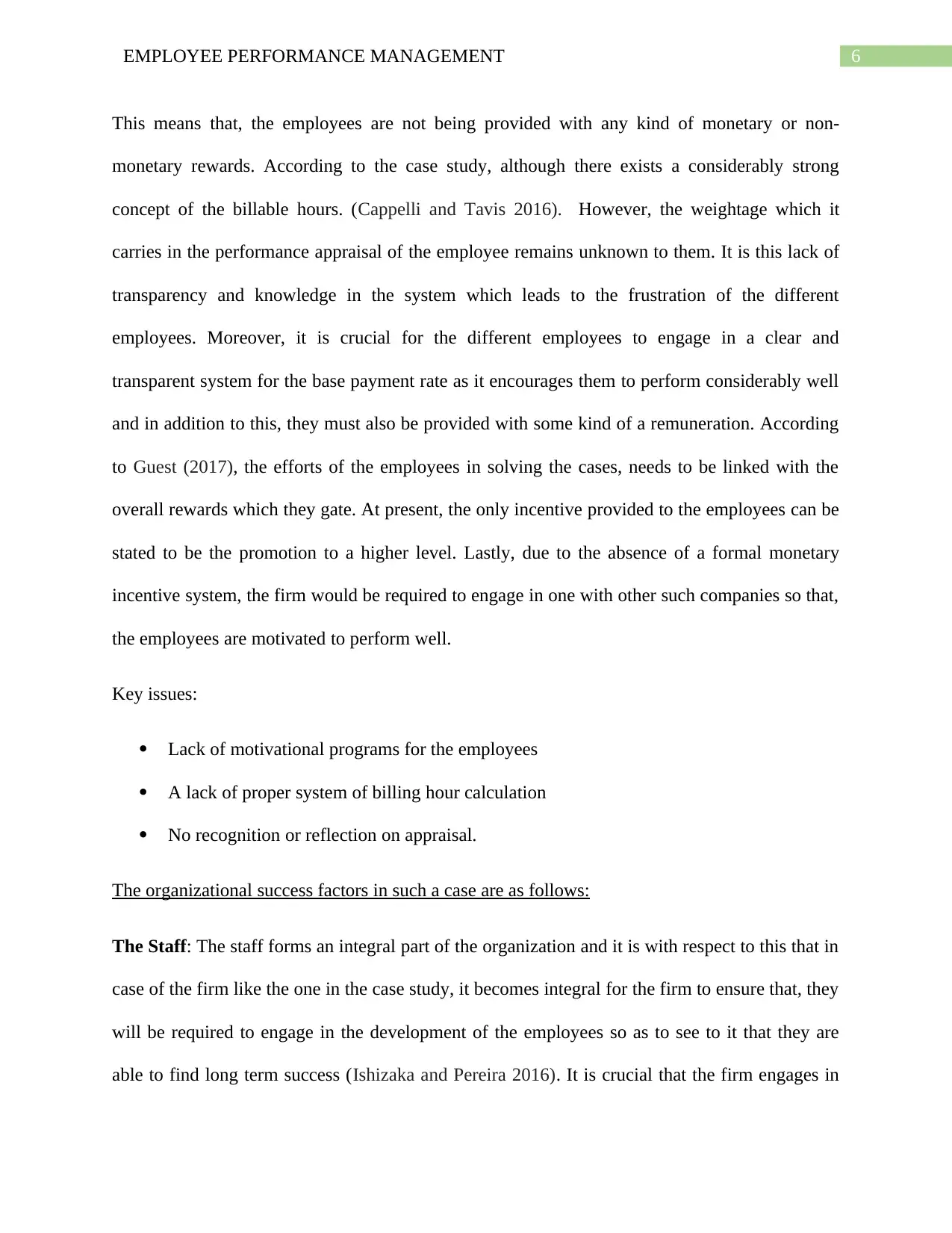
6EMPLOYEE PERFORMANCE MANAGEMENT
This means that, the employees are not being provided with any kind of monetary or non-
monetary rewards. According to the case study, although there exists a considerably strong
concept of the billable hours. (Cappelli and Tavis 2016). However, the weightage which it
carries in the performance appraisal of the employee remains unknown to them. It is this lack of
transparency and knowledge in the system which leads to the frustration of the different
employees. Moreover, it is crucial for the different employees to engage in a clear and
transparent system for the base payment rate as it encourages them to perform considerably well
and in addition to this, they must also be provided with some kind of a remuneration. According
to Guest (2017), the efforts of the employees in solving the cases, needs to be linked with the
overall rewards which they gate. At present, the only incentive provided to the employees can be
stated to be the promotion to a higher level. Lastly, due to the absence of a formal monetary
incentive system, the firm would be required to engage in one with other such companies so that,
the employees are motivated to perform well.
Key issues:
Lack of motivational programs for the employees
A lack of proper system of billing hour calculation
No recognition or reflection on appraisal.
The organizational success factors in such a case are as follows:
The Staff: The staff forms an integral part of the organization and it is with respect to this that in
case of the firm like the one in the case study, it becomes integral for the firm to ensure that, they
will be required to engage in the development of the employees so as to see to it that they are
able to find long term success (Ishizaka and Pereira 2016). It is crucial that the firm engages in
This means that, the employees are not being provided with any kind of monetary or non-
monetary rewards. According to the case study, although there exists a considerably strong
concept of the billable hours. (Cappelli and Tavis 2016). However, the weightage which it
carries in the performance appraisal of the employee remains unknown to them. It is this lack of
transparency and knowledge in the system which leads to the frustration of the different
employees. Moreover, it is crucial for the different employees to engage in a clear and
transparent system for the base payment rate as it encourages them to perform considerably well
and in addition to this, they must also be provided with some kind of a remuneration. According
to Guest (2017), the efforts of the employees in solving the cases, needs to be linked with the
overall rewards which they gate. At present, the only incentive provided to the employees can be
stated to be the promotion to a higher level. Lastly, due to the absence of a formal monetary
incentive system, the firm would be required to engage in one with other such companies so that,
the employees are motivated to perform well.
Key issues:
Lack of motivational programs for the employees
A lack of proper system of billing hour calculation
No recognition or reflection on appraisal.
The organizational success factors in such a case are as follows:
The Staff: The staff forms an integral part of the organization and it is with respect to this that in
case of the firm like the one in the case study, it becomes integral for the firm to ensure that, they
will be required to engage in the development of the employees so as to see to it that they are
able to find long term success (Ishizaka and Pereira 2016). It is crucial that the firm engages in
Paraphrase This Document
Need a fresh take? Get an instant paraphrase of this document with our AI Paraphraser
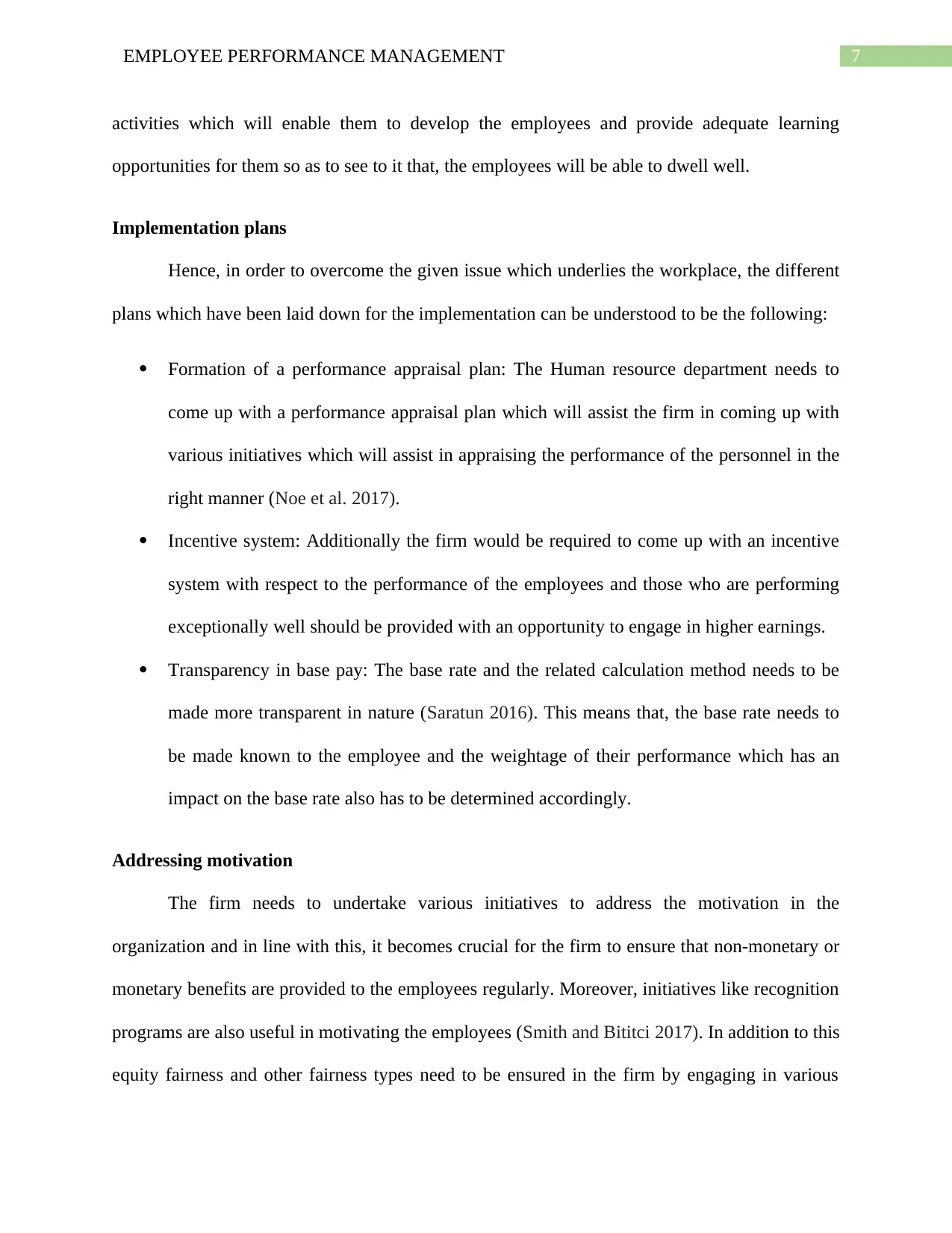
7EMPLOYEE PERFORMANCE MANAGEMENT
activities which will enable them to develop the employees and provide adequate learning
opportunities for them so as to see to it that, the employees will be able to dwell well.
Implementation plans
Hence, in order to overcome the given issue which underlies the workplace, the different
plans which have been laid down for the implementation can be understood to be the following:
Formation of a performance appraisal plan: The Human resource department needs to
come up with a performance appraisal plan which will assist the firm in coming up with
various initiatives which will assist in appraising the performance of the personnel in the
right manner (Noe et al. 2017).
Incentive system: Additionally the firm would be required to come up with an incentive
system with respect to the performance of the employees and those who are performing
exceptionally well should be provided with an opportunity to engage in higher earnings.
Transparency in base pay: The base rate and the related calculation method needs to be
made more transparent in nature (Saratun 2016). This means that, the base rate needs to
be made known to the employee and the weightage of their performance which has an
impact on the base rate also has to be determined accordingly.
Addressing motivation
The firm needs to undertake various initiatives to address the motivation in the
organization and in line with this, it becomes crucial for the firm to ensure that non-monetary or
monetary benefits are provided to the employees regularly. Moreover, initiatives like recognition
programs are also useful in motivating the employees (Smith and Bititci 2017). In addition to this
equity fairness and other fairness types need to be ensured in the firm by engaging in various
activities which will enable them to develop the employees and provide adequate learning
opportunities for them so as to see to it that, the employees will be able to dwell well.
Implementation plans
Hence, in order to overcome the given issue which underlies the workplace, the different
plans which have been laid down for the implementation can be understood to be the following:
Formation of a performance appraisal plan: The Human resource department needs to
come up with a performance appraisal plan which will assist the firm in coming up with
various initiatives which will assist in appraising the performance of the personnel in the
right manner (Noe et al. 2017).
Incentive system: Additionally the firm would be required to come up with an incentive
system with respect to the performance of the employees and those who are performing
exceptionally well should be provided with an opportunity to engage in higher earnings.
Transparency in base pay: The base rate and the related calculation method needs to be
made more transparent in nature (Saratun 2016). This means that, the base rate needs to
be made known to the employee and the weightage of their performance which has an
impact on the base rate also has to be determined accordingly.
Addressing motivation
The firm needs to undertake various initiatives to address the motivation in the
organization and in line with this, it becomes crucial for the firm to ensure that non-monetary or
monetary benefits are provided to the employees regularly. Moreover, initiatives like recognition
programs are also useful in motivating the employees (Smith and Bititci 2017). In addition to this
equity fairness and other fairness types need to be ensured in the firm by engaging in various
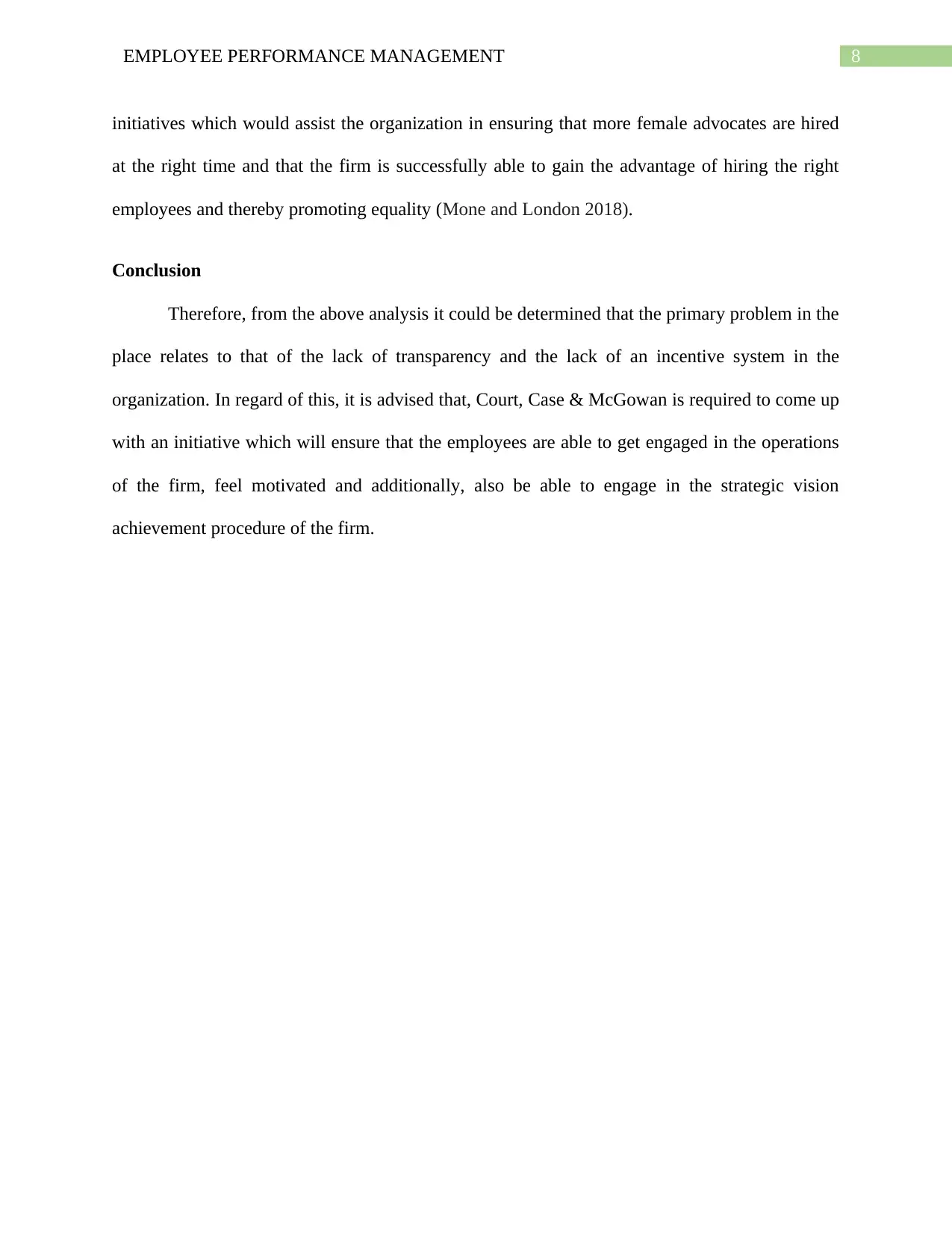
8EMPLOYEE PERFORMANCE MANAGEMENT
initiatives which would assist the organization in ensuring that more female advocates are hired
at the right time and that the firm is successfully able to gain the advantage of hiring the right
employees and thereby promoting equality (Mone and London 2018).
Conclusion
Therefore, from the above analysis it could be determined that the primary problem in the
place relates to that of the lack of transparency and the lack of an incentive system in the
organization. In regard of this, it is advised that, Court, Case & McGowan is required to come up
with an initiative which will ensure that the employees are able to get engaged in the operations
of the firm, feel motivated and additionally, also be able to engage in the strategic vision
achievement procedure of the firm.
initiatives which would assist the organization in ensuring that more female advocates are hired
at the right time and that the firm is successfully able to gain the advantage of hiring the right
employees and thereby promoting equality (Mone and London 2018).
Conclusion
Therefore, from the above analysis it could be determined that the primary problem in the
place relates to that of the lack of transparency and the lack of an incentive system in the
organization. In regard of this, it is advised that, Court, Case & McGowan is required to come up
with an initiative which will ensure that the employees are able to get engaged in the operations
of the firm, feel motivated and additionally, also be able to engage in the strategic vision
achievement procedure of the firm.
⊘ This is a preview!⊘
Do you want full access?
Subscribe today to unlock all pages.

Trusted by 1+ million students worldwide
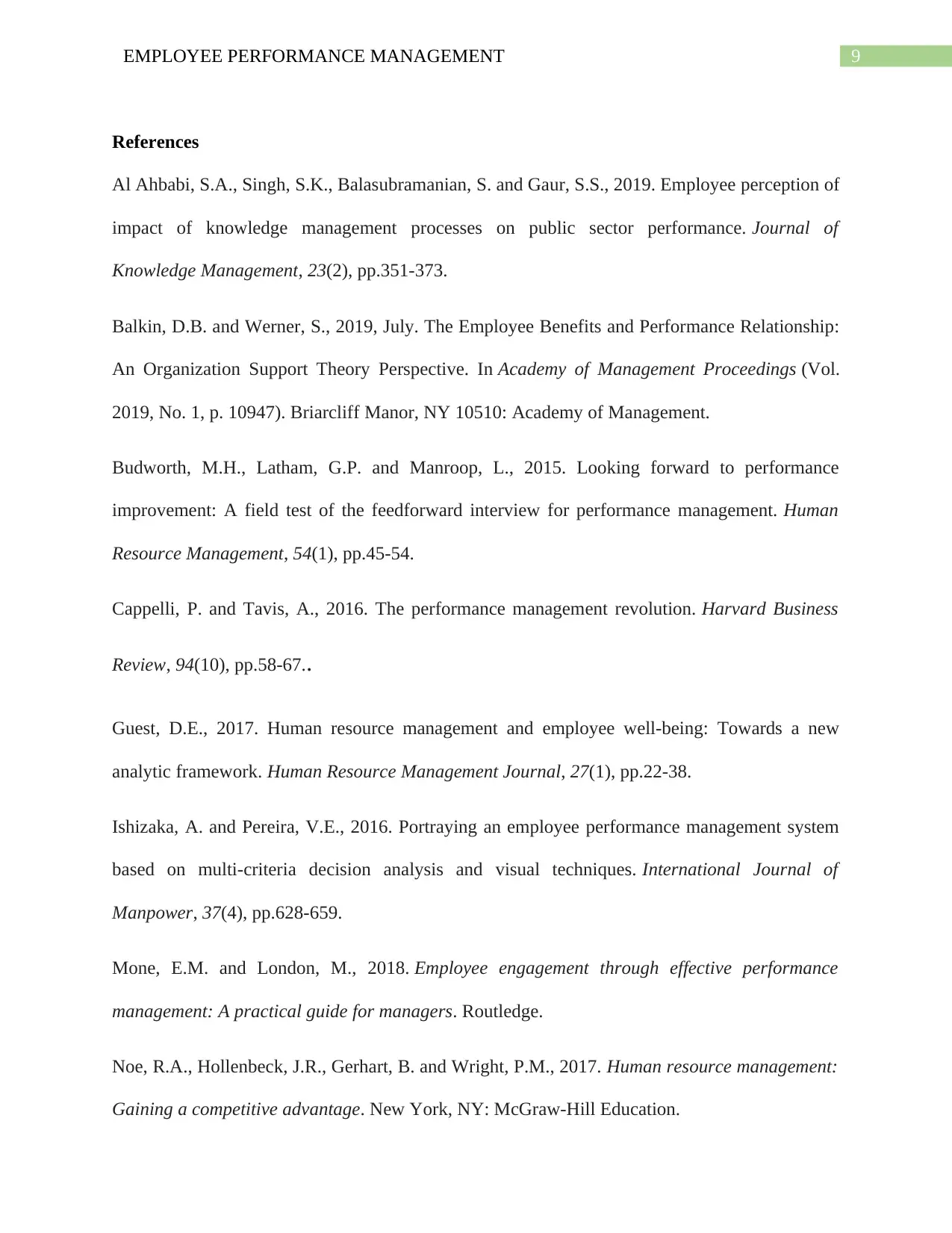
9EMPLOYEE PERFORMANCE MANAGEMENT
References
Al Ahbabi, S.A., Singh, S.K., Balasubramanian, S. and Gaur, S.S., 2019. Employee perception of
impact of knowledge management processes on public sector performance. Journal of
Knowledge Management, 23(2), pp.351-373.
Balkin, D.B. and Werner, S., 2019, July. The Employee Benefits and Performance Relationship:
An Organization Support Theory Perspective. In Academy of Management Proceedings (Vol.
2019, No. 1, p. 10947). Briarcliff Manor, NY 10510: Academy of Management.
Budworth, M.H., Latham, G.P. and Manroop, L., 2015. Looking forward to performance
improvement: A field test of the feedforward interview for performance management. Human
Resource Management, 54(1), pp.45-54.
Cappelli, P. and Tavis, A., 2016. The performance management revolution. Harvard Business
Review, 94(10), pp.58-67..
Guest, D.E., 2017. Human resource management and employee well‐being: Towards a new
analytic framework. Human Resource Management Journal, 27(1), pp.22-38.
Ishizaka, A. and Pereira, V.E., 2016. Portraying an employee performance management system
based on multi-criteria decision analysis and visual techniques. International Journal of
Manpower, 37(4), pp.628-659.
Mone, E.M. and London, M., 2018. Employee engagement through effective performance
management: A practical guide for managers. Routledge.
Noe, R.A., Hollenbeck, J.R., Gerhart, B. and Wright, P.M., 2017. Human resource management:
Gaining a competitive advantage. New York, NY: McGraw-Hill Education.
References
Al Ahbabi, S.A., Singh, S.K., Balasubramanian, S. and Gaur, S.S., 2019. Employee perception of
impact of knowledge management processes on public sector performance. Journal of
Knowledge Management, 23(2), pp.351-373.
Balkin, D.B. and Werner, S., 2019, July. The Employee Benefits and Performance Relationship:
An Organization Support Theory Perspective. In Academy of Management Proceedings (Vol.
2019, No. 1, p. 10947). Briarcliff Manor, NY 10510: Academy of Management.
Budworth, M.H., Latham, G.P. and Manroop, L., 2015. Looking forward to performance
improvement: A field test of the feedforward interview for performance management. Human
Resource Management, 54(1), pp.45-54.
Cappelli, P. and Tavis, A., 2016. The performance management revolution. Harvard Business
Review, 94(10), pp.58-67..
Guest, D.E., 2017. Human resource management and employee well‐being: Towards a new
analytic framework. Human Resource Management Journal, 27(1), pp.22-38.
Ishizaka, A. and Pereira, V.E., 2016. Portraying an employee performance management system
based on multi-criteria decision analysis and visual techniques. International Journal of
Manpower, 37(4), pp.628-659.
Mone, E.M. and London, M., 2018. Employee engagement through effective performance
management: A practical guide for managers. Routledge.
Noe, R.A., Hollenbeck, J.R., Gerhart, B. and Wright, P.M., 2017. Human resource management:
Gaining a competitive advantage. New York, NY: McGraw-Hill Education.
Paraphrase This Document
Need a fresh take? Get an instant paraphrase of this document with our AI Paraphraser
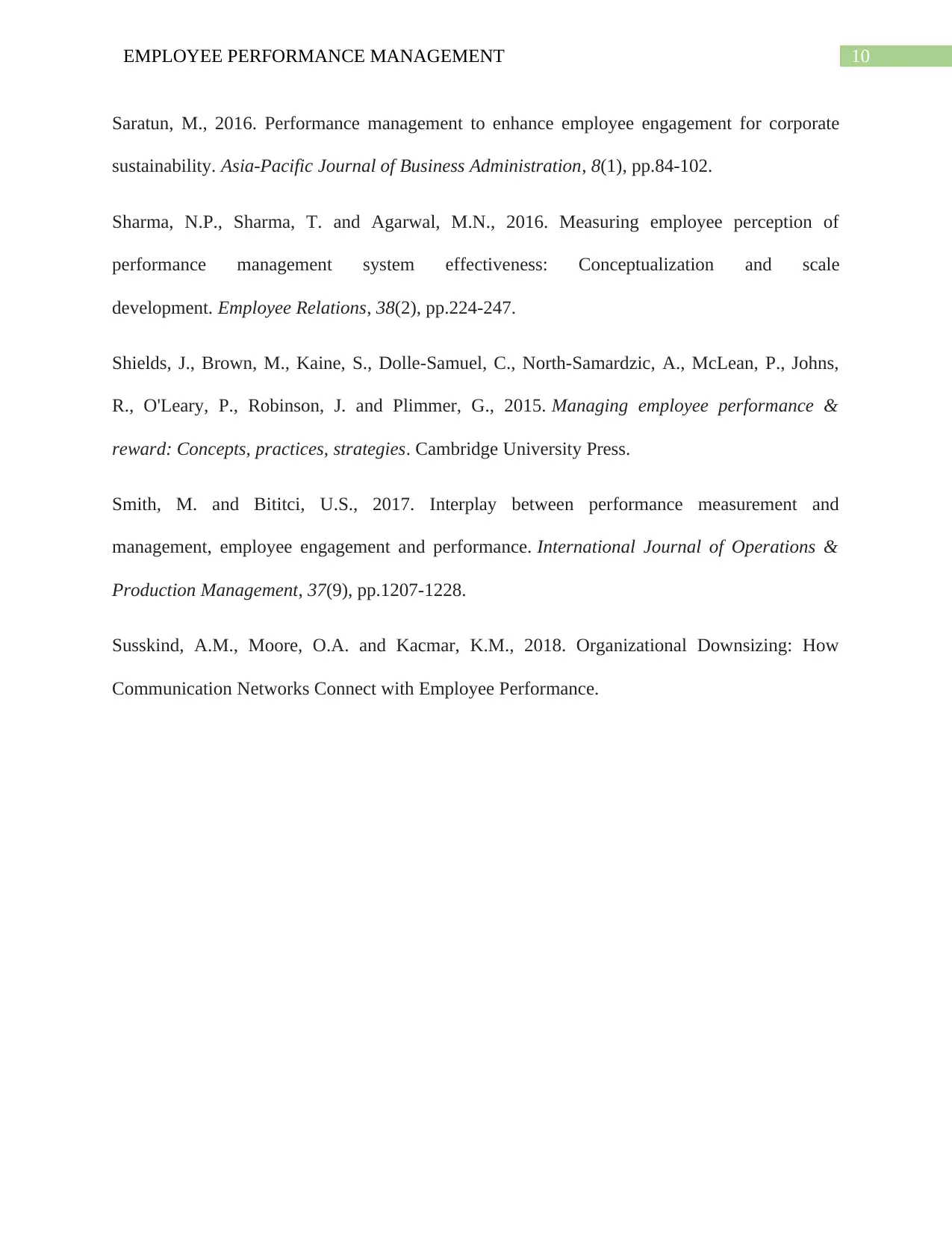
10EMPLOYEE PERFORMANCE MANAGEMENT
Saratun, M., 2016. Performance management to enhance employee engagement for corporate
sustainability. Asia-Pacific Journal of Business Administration, 8(1), pp.84-102.
Sharma, N.P., Sharma, T. and Agarwal, M.N., 2016. Measuring employee perception of
performance management system effectiveness: Conceptualization and scale
development. Employee Relations, 38(2), pp.224-247.
Shields, J., Brown, M., Kaine, S., Dolle-Samuel, C., North-Samardzic, A., McLean, P., Johns,
R., O'Leary, P., Robinson, J. and Plimmer, G., 2015. Managing employee performance &
reward: Concepts, practices, strategies. Cambridge University Press.
Smith, M. and Bititci, U.S., 2017. Interplay between performance measurement and
management, employee engagement and performance. International Journal of Operations &
Production Management, 37(9), pp.1207-1228.
Susskind, A.M., Moore, O.A. and Kacmar, K.M., 2018. Organizational Downsizing: How
Communication Networks Connect with Employee Performance.
Saratun, M., 2016. Performance management to enhance employee engagement for corporate
sustainability. Asia-Pacific Journal of Business Administration, 8(1), pp.84-102.
Sharma, N.P., Sharma, T. and Agarwal, M.N., 2016. Measuring employee perception of
performance management system effectiveness: Conceptualization and scale
development. Employee Relations, 38(2), pp.224-247.
Shields, J., Brown, M., Kaine, S., Dolle-Samuel, C., North-Samardzic, A., McLean, P., Johns,
R., O'Leary, P., Robinson, J. and Plimmer, G., 2015. Managing employee performance &
reward: Concepts, practices, strategies. Cambridge University Press.
Smith, M. and Bititci, U.S., 2017. Interplay between performance measurement and
management, employee engagement and performance. International Journal of Operations &
Production Management, 37(9), pp.1207-1228.
Susskind, A.M., Moore, O.A. and Kacmar, K.M., 2018. Organizational Downsizing: How
Communication Networks Connect with Employee Performance.
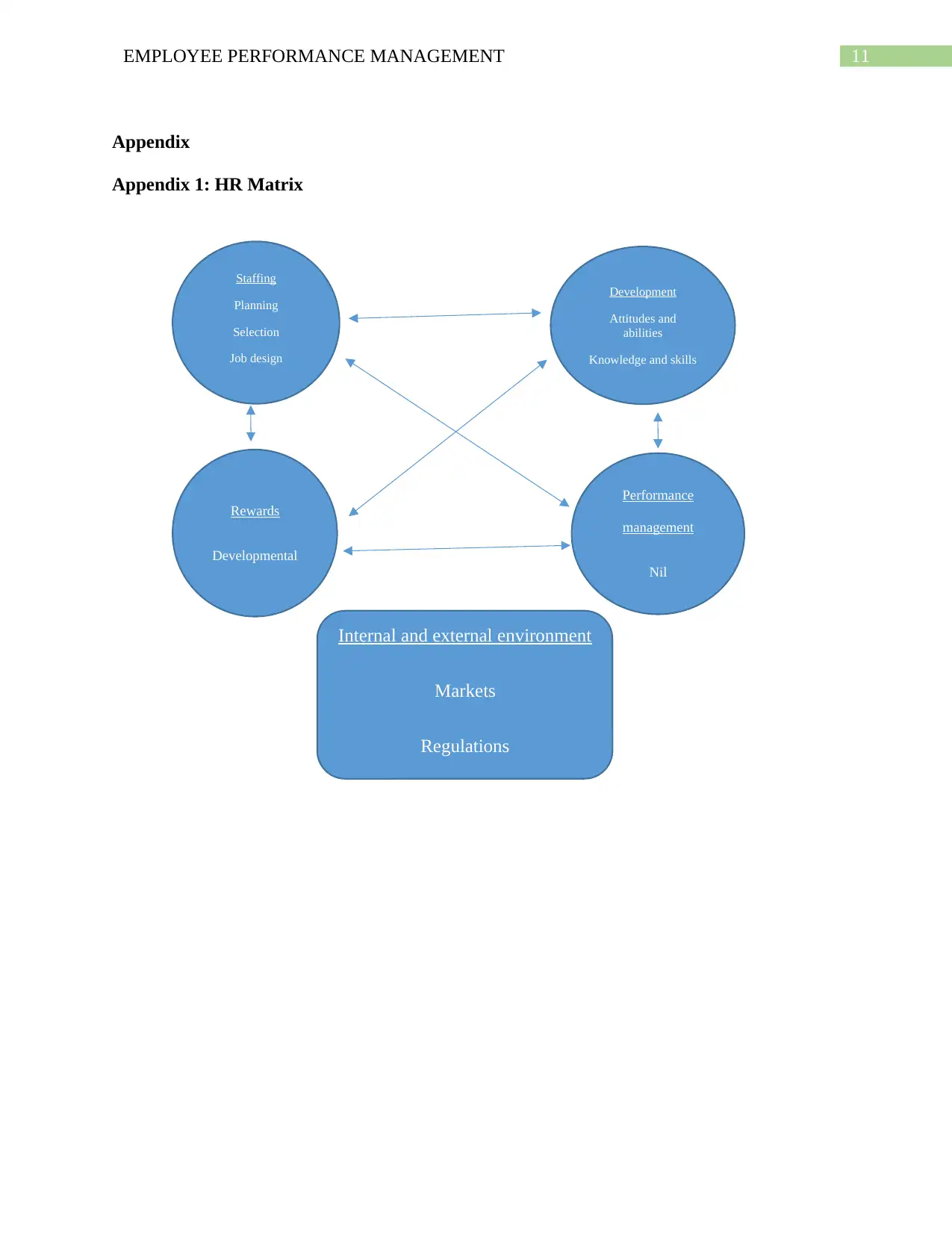
11EMPLOYEE PERFORMANCE MANAGEMENT
Appendix
Appendix 1: HR Matrix
Staffing
Planning
Selection
Job design
Development
Attitudes and
abilities
Knowledge and skills
Rewards
Developmental
Performance
management
Nil
Internal and external environment
Markets
Regulations
Appendix
Appendix 1: HR Matrix
Staffing
Planning
Selection
Job design
Development
Attitudes and
abilities
Knowledge and skills
Rewards
Developmental
Performance
management
Nil
Internal and external environment
Markets
Regulations
⊘ This is a preview!⊘
Do you want full access?
Subscribe today to unlock all pages.

Trusted by 1+ million students worldwide
1 out of 13
Related Documents
Your All-in-One AI-Powered Toolkit for Academic Success.
+13062052269
info@desklib.com
Available 24*7 on WhatsApp / Email
![[object Object]](/_next/static/media/star-bottom.7253800d.svg)
Unlock your academic potential
Copyright © 2020–2025 A2Z Services. All Rights Reserved. Developed and managed by ZUCOL.





